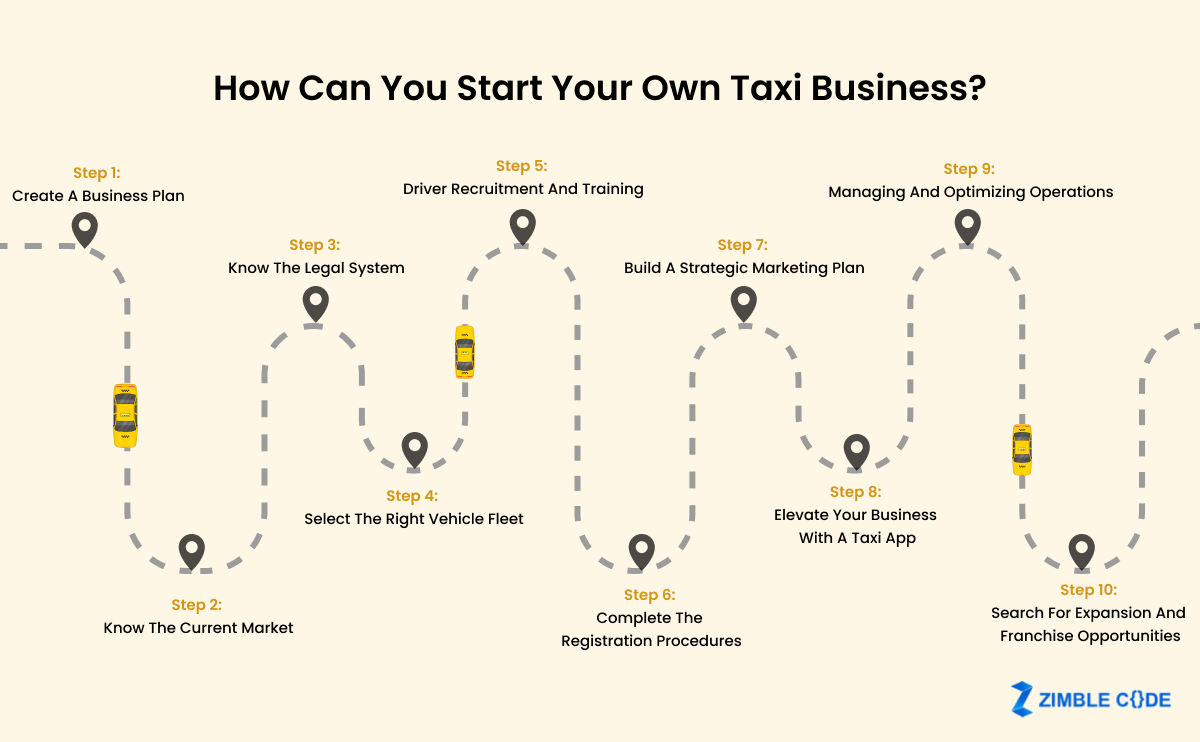Did you know?
The online taxi service market is poised for substantial growth, with a projected value of $56.37 billion by 2027, boasting a robust 10% CAGR.
Looking into the future, the taxi app market is gearing up to reach a staggering $283 billion by 2028, driven by a steady 4.2% CAGR from 2023 to 2028.
Platforms such as DiDi and Uber attract approximately 150 million of the 300 million taxi app users worldwide.
These statistics highlight the immense potential within the industry, rendering it an appealing prospect for newcomers and those seeking expansion opportunities.
Thus, if you plan to start your own taxi business in London, UK, it is an exciting opportunity. With the rise of ride-sharing and technological advancements, this seems to be the perfect time for offering rapid and dependable transportation services to diverse customers, from daily commuters to tourists and business travelers.
How Can You Start Your Own Taxi Business?
Starting your own taxi business in London, UK, is a thrilling entrepreneurial venture in one of the world’s most dynamic and diverse cities. In this bustling metropolis with a thriving taxi service market, this guide will be your trusted companion, leading you through the crucial steps required to establish and operate a successful taxi business.

Step 1: Create a Business Plan
Creating a successful taxi business depends on a well-defined business plan. Start by solidifying your concept, understanding the key components, assessing requirements, and launching.
Your plan must prioritize both customer satisfaction and profits. Your unique business idea sets you apart from competitors, making market research essential for staying competitive. Importantly, it’s a cost-free process that yields valuable insights.
Step 2: Know the Current Market
Understanding the current market is vital as it provides insights into the potential business type and scale suitable for your venture. It’s essential to familiarize yourself with the market landscape. Assessing your competitors in the taxi industry will help gauge the demand in your chosen operational area.
Opting for regions with established taxi services can offer valuable guidance when deciding to commence or run your business. Leveraging insights from existing enterprises can empower you with the essential knowledge needed to make well-informed decisions.
Step 3: Know the Legal System
Understanding the legal framework is the subsequent step after devising your strategy for a thriving taxi business in the UK. This entails fulfilling essential requirements, including legal and insurance protocols.
Obtaining the necessary licenses to operate a taxi service is non-negotiable and should not be underestimated. Timely completion of all required paperwork is crucial to prevent any potential fines or legal issues.
Step 4: Select the Right Vehicle Fleet
Selecting the right vehicle fleet is vital for your taxi business. Consider your target market and choose reliable, safe, and comfortable cars that align with passenger preferences. Fuel efficiency is critical, and you can opt for conventional sedans, hybrids, or specialized vehicles.
Ensure compliance with local laws and safety standards and maintain your fleet for a satisfying passenger experience. Investing in well-kept cars builds trust and paves the way for a thriving and profitable taxi business.
Step 5: Driver Recruitment and Training
A critical early step in launching a taxi service is hiring and training drivers. Look for individuals with clean driving records, valid licenses, and a customer-focused attitude. Thoroughly screen their backgrounds for trustworthiness. Emphasize professionalism, punctuality, and courtesy.
Regularly assess driver performance and offer feedback to enhance the customer experience, build your company’s reputation, and foster customer loyalty for long-term success in the competitive taxi industry.
Step 6: Complete the Registration Procedures
Choosing the proper legal structure, whether a sole proprietorship or an LLC, is essential. Register your business with local government agencies, securing the necessary licenses and permits for lawful operation.
Having proper registration not only establishes credibility but also protects your assets and ensures compliance with local regulations, setting the stage for a smooth and ethical process. Additionally, obtaining adequate insurance offers peace of mind, allowing your taxi service to operate confidently and safeguard your assets in unforeseen circumstances.
Step 7: Build a Strategic Marketing Plan
Effective marketing is vital for your taxi business’s success. First, understand your target market, tailor your approach to their preferences, and then utilize various platforms like social media, local advertising, and digital marketing to reach potential customers. It will enable you to attract new riders and encourage repeat business with promotions, discounts, and referrals.
In addition to it, you can boost brand visibility by branding your taxi fleet in London, UK, with your logo. Monitor your marketing efforts and adjust as needed for maximum success. By prioritizing a solid brand and excellent customer experiences, your taxi business can excel in a competitive industry and achieve long-term success.
Step 8: Elevate Your Business with a Taxi App
Incorporating a taxi app into your car taxi business can be a game-changer, benefiting both drivers and passengers. It streamlines booking, offers diverse payment options, and enhances navigation. For drivers, it simplifies scheduling and elevates customer service. The app enables cashless payments and delivers valuable data insights. Whether you develop a custom app or collaborate with existing services, embracing technology through a well-crafted taxi app can expedite your taxi business’s success, elevating the user experience and fostering growth while increasing customer satisfaction.
Step 9: Managing and Optimizing Operations
Managing and optimizing operations is crucial for the long-term success of a taxi business. You must constantly monitor key performance indicators like revenue, customer satisfaction, driver performance, and fleet maintenance. Regularly evaluate your business’s performance to identify areas for improvement and cost-saving measures, and do not forget to utilize technology for efficient management.
Additionally, staying innovative and adaptable is vital to outperform competitors and meet evolving market demands. By consistently monitoring and improving operations, you can create a more efficient and customer-centric taxi company that thrives in a competitive market.
Step 10: Search for Expansion and Franchise Opportunities
Exploring expansion and franchise possibilities is a pivotal phase when initiating a taxi business. Once your business gains traction and a solid foothold in its initial market, it becomes essential to consider growth opportunities.
Expanding your services to new regions or extending franchising options to interested entrepreneurs can significantly enhance your business’s reach and profitability. This step requires thorough market analysis, legal evaluations, and formulating a robust expansion or franchise strategy to ensure a successful and enduring path for your taxi business’s growth.
Final words
The taxi business market in London, UK, offers abundant opportunities for budding entrepreneurs. With a vibrant and varied customer base and the city’s ever-changing transportation scene, initiating a taxi business can prove to be a fulfilling pursuit. The market’s anticipated growth, potential technological advancements, and possibilities for expansion all enhance the appeal of this enterprise. It is worth considering the launch of a taxi business in London, UK, with the right planning, commitment, and dedication to excellent service.
Read Also – How Much Does It Cost To Build A Taxi Dispatch Software Like Uber?
Frequently Asked Questions (FAQs)
Q1. How can you market your Taxi business?
Marketing tactics include social media, online advertising, flyers, partnerships with schools/businesses, promotions, sponsoring kids’ events, and more. Focus on showcasing your safety practices and superior service.
Q2. How can I ensure the safety and reliability of my taxi service?
Safety and reliability in your taxi service are assured through driver background checks, regular vehicle maintenance, and real-time GPS tracking.
Q3. How much does it cost to build a basic taxi app?
Creating a basic taxi app for one platform with essential features like ride booking, GPS tracking, and payment integration can cost between $20,000 and $50,000.









Leave A Comment